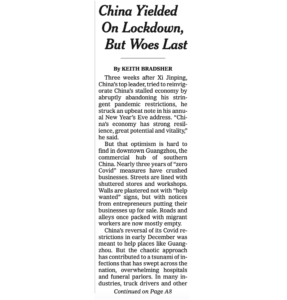China is on pace to meet its pledge to buy 12 million tons of US soybeans by the end of February, US Treasury Secretary Scott Bessent said on Wednesday, appearing…
China: Road to Recovery Could “Be Uneven and Painful”
Keith Bradsher reported on the front page of Tuesday’s New York Times that, “China’s reversal of its Covid restrictions in early December was meant to help places like Guangzhou [the commercial hub of southern China]. But the chaotic approach has contributed to a tsunami of infections that has swept across the nation, overwhelming hospitals and funeral parlors. In many industries, truck drivers and other workers have quickly fallen ill, temporarily stretching staff and slowing operations.
Now, faced with an unpredictable — and uncontrolled — epidemic and financial uncertainty, people and companies are spending cautiously, suggesting that the road to recovery will be uneven and painful.
“China is also confronting broader challenges beyond its borders. The global economy is slowing, dragged down by high inflation, an energy crisis and geopolitical turmoil. As American and European shoppers tighten their budgets, China increasingly faces a double blow of slumping demand both at home and abroad.

“Weak spending is further depressing the already razor-thin or nonexistent profit margins of many of the small private businesses that power China’s economy.”
Bradsher explained that, “China’s factory activity contracted further in December as rapidly spreading infections grounded workers, snarled deliveries and dampened demand, according to a survey of manufacturers that the government released on Saturday. For service industries like restaurants, the same survey found, business was almost as bad as in early 2020, during the nearly nationwide lockdown that followed the first Covid outbreak in the city of Wuhan. Eateries and other businesses closed last month as customers stayed home to avoid infection or because they were sick.”
Nonetheless, the Times article noted that, “But even as many cities and provinces are in the throes of deadly outbreaks that have silenced once-busy streets, in other places, there are early signs that economic activity is resuming. In a few cities in northern China like Beijing, which saw widespread outbreaks that have since peaked, people have been going out again in recent days.”
“The Communist Party has pledged to spur domestic demand to revive growth. But convincing people to spend after three years of stop-start activity and punishing lockdowns will be tough. Many Chinese workers are now looking for ways to rebuild their savings, even as the Lunar New Year holiday approaches, a time when families used to splurge,” the Times article said.
Elsewhere, an update last week at The Financial Times Online reported that, “Beijing’s streets are once again jammed with traffic, tourists are rushing to book foreign holidays and businesses anticipate a pick-up in activity as China’s economy reawakens from three years of coronavirus restrictions, even as the country endures its worst outbreak of the pandemic.
“While China remains submerged in an unprecedented wave of coronavirus, with tens of millions infected daily, the world’s second-largest economy is starting to show signs of coming back to life following the government’s decision this month to abruptly dismantle the draconian zero-Covid system that sought to control the virus at the cost of keeping the country isolated.
“Investors and analysts predict a brighter year ahead after Covid disrupted supply chains and forced stoppages on factory floors, as the economy recovers and begins to reconnect with the rest of the world.”
The FT article added that, “Consumer spending, which has been particularly vulnerable to zero-Covid lockdowns, with retail sales in November dropping 6 per cent year on year, is expected to grow. Analysts at Citi on Tuesday forecast retail sales would grow 11 per cent during 2023 to Rmb50tn ($7tn) and suggested that it was possible most major cities would pass the peak wave of infections before the middle of January.”
And with respect to data and Covid spread in China, Alexandra Stevenson and Benjamin Mueller reported on the front page of Friday’s New York Times that, “Until [December], the world seemed to have a reasonably clear understanding of what was happening with the virus in China. The ruling Communist Party proudly published low daily case numbers and deaths as a testament to its stringent ‘zero Covid’ policy. A countrywide system of lockdowns, quarantines and mass testing largely kept the virus at bay.
“But in early December, the government abruptly abandoned ‘zero Covid,’ leaving the scientific community largely in the dark.
“‘Nobody, nobody has a clue,’ said Siddharth Sridhar, a clinical virologist with a focus on emerging infectious diseases.”

More broadly on U.S. trade policy with China, Bloomberg writer Bryce Baschuk reported yesterday that, “At the midpoint of President Joe Biden’s initial term in office it’s clear there is one overriding priority that drives all economy policy: Competition with China.”
The Bloomberg article stated that, “Going forward, we can expect to see the Biden administration to pursue a two-pronged China strategy that involves:
- Running faster by supporting job-creating American industries, and
- Slowing China by imposing new trade barriers and export controls.
“A major looming question for the administration in the coming year is whether it can convince US allies to fully embrace Biden’s China strategy.”
Meanwhile, Dow Jones writer Yusuf Khan reported yesterday that, “Risk assets are looking to China this week as the country moves ahead with its reopening plans despite rising cases of Covid-19 in the country.
“For agricultural futures, ‘traders are optimistic that China’s reopening will benefit global risk assets and commodity demand,’ according to Peak Trading Research’s head of research Dave Whitcomb.”





